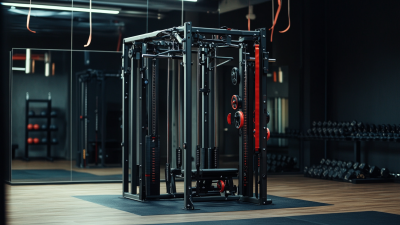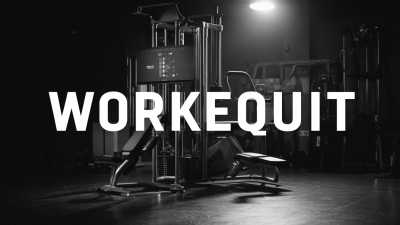Unleashing Your Potential with the Ultimate Functional Trainer Guide
The evolution of fitness training has seen a remarkable shift towards functional training, with the global functional training market expected to reach $4.2 billion by 2027, growing at a CAGR of 10.8% from 2020 to 2027 (source: Allied Market Research). This surge reflects a growing awareness among fitness enthusiasts and professionals alike of the importance of exercises that enhance everyday movements and improve overall functional capacity.

Understanding the Basics: What is a Functional Trainer and Its Benefits
Functional training has gained prominence in recent years, revolutionizing the way individuals approach fitness. At its core, a functional trainer is a versatile piece of equipment that allows users to enhance their strength, flexibility, and coordination through movements that replicate everyday activities. According to a report by the American Council on Exercise (ACE), functional training can improve overall fitness levels by engaging multiple muscle groups simultaneously, which not only burns more calories but also enhances stability and balance. This holistic approach to training is particularly beneficial for athletes and older adults looking to maintain their independence.
The benefits of functional trainers extend beyond mere physical fitness; they also promote better functional movement patterns, which can lead to a reduced risk of injuries. A study published in the Journal of Sports Science and Medicine found that individuals who participated in functional training programs experienced a 30% decrease in injury rates compared to those who followed traditional strength training regimens. By incorporating exercises like squats, lunges, and rotational movements, functional trainers prepare the body for real-life challenges, ensuring that users not only build muscle but also improve their overall quality of life.
Understanding the Benefits of Functional Training
Key Exercises: Essential Movements for Maximizing Your Workout
The foundation of an effective workout lies in mastering key exercises that engage multiple muscle groups and enhance overall functional fitness. Essential movements such as squats, deadlifts, push-ups, and kettlebell swings not only promote strength but also improve balance, stability, and flexibility. Squats, for instance, activate the quads, hamstrings, and glutes while mimicking the natural movement of sitting down and standing up, making them a vital component of any workout routine. Incorporating these movements into your training regimen can lead to better performance in daily activities and athletic endeavors alike.
In addition to traditional weight training, functional trainers allow for the integration of dynamic and compound movements that challenge your coordination and endurance. Exercises like cable woodchoppers and resistance band rows engage the core and upper body simultaneously, enhancing rotational strength and improving posture. By prioritizing these essential movements, you can maximize your workout efficiency, ultimately unleashing your true potential and achieving your fitness goals more effectively.
Unleashing Your Potential with the Ultimate Functional Trainer Guide - Key Exercises: Essential Movements for Maximizing Your Workout
| Exercise | Muscle Group Targeted | Sets | Repetitions | Equipment Needed |
|---|---|---|---|---|
| Squats | Legs, Glutes | 3 | 10-15 | None / Barbell |
| Push-Ups | Chest, Triceps | 3 | 8-12 | None |
| Deadlifts | Back, Legs | 4 | 6-10 | Barbell |
| Pull-Ups | Back, Biceps | 3 | Max | Pull-Up Bar |
| Planks | Core | 3 | 30-60 secs | None |
Creating a Customized Workout Plan for Your Functional Training Goals
Creating a customized workout plan for your functional training goals is essential for maximizing your potential and achieving optimal results. The first step is to assess your individual fitness level, identify your strengths and weaknesses, and determine your specific functional training objectives. Whether you aim to improve your strength, endurance, flexibility, or overall athletic performance, tailoring your regimen to meet these goals will set the foundation for success. Incorporating a mix of compound movements, stability exercises, and agility drills can enhance your overall functionality and prepare you for everyday activities.
Next, it's important to set a timeline and establish measurable milestones to track your progress. Incorporate a variety of training modalities, such as resistance training, balance exercises, and cardiovascular workouts, to ensure a well-rounded approach. Adjusting the intensity and duration of your workouts based on your evolving capabilities will keep you motivated and engaged. Remember, consistency is key; maintaining a regular schedule and allowing for adequate recovery will help you avoid burnout and injury, ultimately leading to a more fulfilling and effective functional training experience.
Common Mistakes to Avoid When Using a Functional Trainer
When utilizing a functional trainer, avoiding common mistakes is crucial for maximizing workout effectiveness and reducing the risk of injury. One prevalent mistake is neglecting proper form. According to a 2022 report by the National Academy of Sports Medicine, about 70% of gym-goers experience some form of injury due to improper technique. This is particularly relevant in functional training, which emphasizes controlled movements that mimic everyday activities. Ensuring that your alignment and positioning are correct not only enhances performance but also protects your joints.
Another significant error is failing to incorporate a balanced routine. A survey by the American Council on Exercise indicated that 65% of fitness enthusiasts tend to focus on specific muscle groups while ignoring others, leading to imbalances that can hinder progress. A well-rounded functional training program should engage multiple muscle groups and incorporate flexibility, strength, and stability exercises. By adhering to a comprehensive approach and being mindful of these common pitfalls, individuals can unlock their full potential and achieve their fitness goals more effectively.

Tracking Progress: How to Measure Success with Functional Training
 When engaging in functional training, measuring progress is essential to ensure you're on the right path toward unleashing your full potential. Tracking your success not only boosts motivation but also helps identify areas for improvement. By setting clear and specific goals, you create a framework that allows for effective measurement. Use tools like fitness apps or journals to regularly log your workouts, noting the exercises, repetitions, and weights used.
When engaging in functional training, measuring progress is essential to ensure you're on the right path toward unleashing your full potential. Tracking your success not only boosts motivation but also helps identify areas for improvement. By setting clear and specific goals, you create a framework that allows for effective measurement. Use tools like fitness apps or journals to regularly log your workouts, noting the exercises, repetitions, and weights used.
Tips: To stay motivated, celebrate small milestones. For example, if you can perform an additional repetition or lift a heavier weight, acknowledge this achievement as part of your journey. Additionally, consider incorporating assessments such as mobility tests or performance benchmarks every few weeks to gauge progress.
Another effective method of tracking success is through visual progress indicators, such as photos or body measurements. Taking time-stamped pictures allows you to visually appreciate your transformation, while measurements can provide quantitative evidence of your improvements. By combining multiple methods of tracking, you'll have a comprehensive view of your progress, which can inspire you to push your limits further.
Related Posts
-

7 Essential Insights for Global Buyers of Exercise Equipment
-

Ultimate Guide to Choosing the Perfect Functional Trainer for Your Workout Needs
-

Exploring the Versatility of Exercise Equipment: Features, Benefits, and Ideal Use Cases
-

Complete Manual for Choosing the Right Functional Trainer for Your Fitness Facility
-

Future of Workout Equipment Innovations for 2025 and Beyond Guide
-

Setting the Benchmark in Best Workout Equipment Through Industry Standards and Data Analysis
